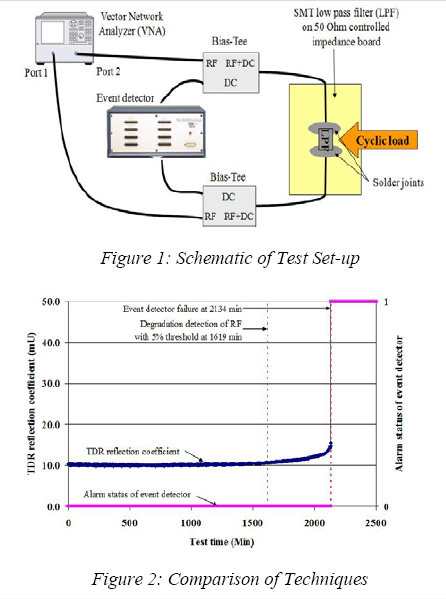![]() Tools and Techniques for Prognostics and Health Management
Tools and Techniques for Prognostics and Health Management
PI: CALCE (Center for Advanced Life Cycle Engineering)
Prognostics is the process of predicting the future reliability of a product by assessing the product’s extent of deviation or degradation from its expected normal operating conditions. PoF-based prognostics utilizes knowledge of a product's life cycle loading conditions, geometry, material properties, and failure mechanisms to estimate its remaining useful life. Data-driven prognostics uses statistics and probability for analyzing current and historical data to estimate remaining useful life. The fusion approach combines the PoF and datadriven approaches to provide online diagnosis and estimation of remaining useful life of a product.
Testing an Approach
Traditional methods used to monitor interconnect reliability are based on the measurement of DC resistance since it is well-suited for characterizing electrical continuity, but is not useful for detecting a partially degraded interconnect. Degradation of interconnects, such as cracking of solder joints due to fatigue or shock loading, usually initiates at an exterior surface and propagates towards the interior. At frequencies above several hundred MHz, signal propagation is concentrated at the surface of interconnects, a phenomenon known as the skin effect. Many types of electronic products require transmission of signals in the GHz range. For these products even a small crack at the surface of an interconnect may adversely affect the performance. RF impedance monitoring offers a more sensitive and reproducible means of sensing interconnect degradation than DC resistance. In order to demonstrate this, a simple test vehicle that contained two solder joints was developed and employed under cyclic stress conditions. Figure 1 shows the setup schematic. Simultaneous measurements of DC resistance and time domain reflection coefficient as a measure of RF impedance were conducted to allow a direct comparison of their respective sensitivities in detecting physical degradation of the solder joints. The RF impedance was observed to increase in response to the early stages of cracking of the solder joint while the DC resistance remained constant. Failure analysis revealed that the RF impedance increase resulted from a physical crack, which initiated at the surface of the solder joint and propagated only partway across the solder joint. Figure 2 shows the plot of RF impedance and event detector data.

Conclusions
These results indicate that RF impedance can serve as a non-destructive early indicator of solder joint degradation. The continuous monitoring of RF impedance during a stress test provides a direct means of monitoring the health of an interconnect. RF impedance monitoring can be used as a prognostic tool. In situ measurements of the failure precursor can be used to trigger an alarm to provide condition-based maintenance, thereby increasing product availability, reducing unplanned downtime, and bringing substantial savings in operational, repair, logistical, and liability costs. This technique can improve real-time reliability prediction of electronic products when incorporated into sensing circuitry in the product.

